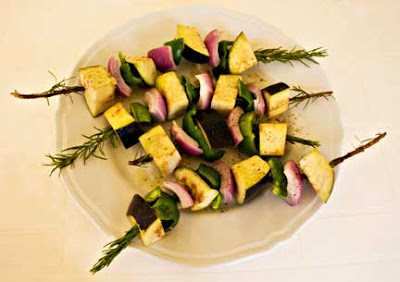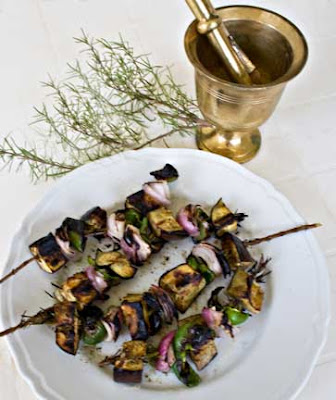(From Greece)
Summer tomatoes are a glory of Greece. Red and juicy, warmed by the sun and simply seasoned with salt, Greek tomatoes explode with flavor, bathing taste buds in their sweet-yet-tart goodness.
We arrived in Greece this (and every) year during tomato season. Our relatives, friends, and neighbors greet us with food, which always includes lots of luscious fresh tomatoes. Right now, there are at least ten pounds of gorgeous tomatoes sitting on the counter, and the refrigerator is packed with grapes, okra, peppers, and other seasonal vegetables. It’s the best possible welcome home gift. We happily use the bounty.
 One of the best ways to eat summer tomatoes is in Horiatiki Salata (Village Salad), a mix of tomatoes, cucumbers, onions, green pepper, and feta cheese, dressed only with olive oil and salt. This most beloved of Greek salads appears on taverna menus throughout the country. During tomato season in Greece, we eat a variation of Horiatiki Salata every day.
One of the best ways to eat summer tomatoes is in Horiatiki Salata (Village Salad), a mix of tomatoes, cucumbers, onions, green pepper, and feta cheese, dressed only with olive oil and salt. This most beloved of Greek salads appears on taverna menus throughout the country. During tomato season in Greece, we eat a variation of Horiatiki Salata every day.
Many Greeks like salad tomatoes when they’re still slightly green. I prefer them at their peak of ripeness. When I’m eating salad with Greek relatives, this balances out perfectly. I snag the reddest tomato bits. They go for the greener parts.
It’s hot on the island during tomato days. I’m not a hot weather aficionado, but appreciate that heat helps give Greek tomatoes their superior flavor.
At this time of year, light, flavorful, quick-cooked foods are welcome. They help avoid spending too much time in hot kitchens. One favorite such Greek dish is Scrambled Eggs and Tomatoes. In some places it’s called Strapatsada, in others Kayianas, Menemeni or Sfoungato Politiko, and in many it’s simply Eggs and Tomatoes (Avga me Domates/Αυγά με Ντομάτες).
 The Greek name “Strapatsada” derives from the Italian for “scrambled eggs” (“uova strapazzate”). Some say the dish was originally brought to Greece by Sephardic Jews. If true, given the Italian name, a plausible route is via the Venetian Jews to the Jews in Corfu and the significant Jewish population that used to exist in Thessaloniki. (Most Greek Jews died in German concentration camps during World War II; today the entire Jewish population of Greece is about 5000.) Certainly, Strapatsada is consistent with Jewish dietary restrictions.
The Greek name “Strapatsada” derives from the Italian for “scrambled eggs” (“uova strapazzate”). Some say the dish was originally brought to Greece by Sephardic Jews. If true, given the Italian name, a plausible route is via the Venetian Jews to the Jews in Corfu and the significant Jewish population that used to exist in Thessaloniki. (Most Greek Jews died in German concentration camps during World War II; today the entire Jewish population of Greece is about 5000.) Certainly, Strapatsada is consistent with Jewish dietary restrictions.
Although some debate the Jewish connection, it’s commonly accepted that Strapatsada as a Greek name for Scrambled Eggs and Tomatoes originated in the Ionian Islands (including Corfu) during their years of Venetian rule (1401 – 1797). See also Voice of Corfu: “… tomatoes … were brought to Corfu by the Venetians.” It’s documented that after the Venetian conquest, Corfiot Jews developed close relations with the Venetian Jewish community and its many international merchants and traders. Cookbook of the Jews of Greece, Nicholas Stavroulakis (Lycabettus Press 1986).
According to food historian Claudia Roden, the 16th and 17th century Jewish merchants of Venice “traded with their relatives and co-religionists around the Mediterranean … [and others] in South America.” Roden says the Jewish merchants “introduced New World food products such as tomatoes…” throughout the entire Mediterranean Jewish community.
Roden points out “a tomato sauce in Venice is called ‘alia giudia’” (Jewish Style). In her history of Italian Jewish cooking, The Classic Cuisine of the Italian Jews: Traditional Recipes and Menus and a Memoir of a Vanished Way of Life (Giro Press 1993), Edda Servi Machlin says: “In the 18th century, the first people who used tomatoes in their cooking were Jews.”
See also, “[S]ome of the [Sephardim] … traveled as merchants to the New World, bringing back a whole new range of vegetables which were quickly adopted into the Sephardic kitchen. These were adopted, in turn, by the others among whom they lived, especially as the Sephardim were dispersed through the Mediterranean basin, into the Balkans, and parts of Western Europe.”
The Jews were also among the first to bring tomatoes to England and America. In his 1753 supplement to A History of Plantes (Thomas Osborne 1751), John Hill documented the use of tomatoes “eaten stewed or raw” by Jewish families in England. The tomato-eating 18th century English Jews “were of Portuguese or Spanish descent and … maintained contact with Jewish communities in the New World who consumed tomatoes.” The Tomato in America, Andrew F. Smith (University of South Carolina Press 1994). Smith says “at least one English-born Jewish physician introduced tomatoes into Virginia during the mid-18th century.”
If the conventional wisdom is correct that Strapatsada came to Corfu during the Venetian years, and we accept the historical record that Jews adopted tomatoes into their diets by at least the mid-18th century (and probably earlier), it isn’t too far-fetched to believe that Strapatsada was originally a Jewish creation. Indeed, Cookbook of the Jews of Greece and Γεύση από Σεφαραδιτική Θεσσαλονίκη: Συνταγές των Εβραίων της Θεσσαλονίκης (Tastes of Sephardic Thessaloniki: Recipes of the Jews of Thessaloniki), Νίνα Μπενρουμπή (Φυτράκη 2002), which document the traditional foods of Greek Jews, both have recipes for Strapatsada.
It could be that tomatoes weren’t used anywhere in Greece until the 19th century. And, as with all simple food combinations, it’s entirely possible that each version of Scrambled Eggs and Tomatoes was created independently and spontaneously by creative cooks making use of seasonally fresh foods.
No matter its origin or name, Scrambled Eggs and Tomatoes is easy to make and very flavorful. It’s especially good when made with sun-ripened summer tomatoes.
 Scrambled Eggs and Tomatoes (Strapatsada – Στραπατσάδα)
Scrambled Eggs and Tomatoes (Strapatsada – Στραπατσάδα)
Serves 2
When I make Strapatsada with fresh sweet summer tomatoes, I use mint to season it. Mint’s flavor enhances the tomatoes’ sweetness and goes well with eggs. Made with canned tomatoes, dried oregano makes a better seasoning for Strapatsada. In our house, three eggs are plenty for two people, but eaters with hearty appetites may prefer four eggs. I like the finished egg curds to be smooth-textured so skin the tomatoes. Skinning is not necessary; the Strapatsada will taste great if you leave on the skins. To make the simplest version of Strapatsada, cook tomatoes in olive oil until their water evaporates, then scramble in the eggs, seasoning only with salt and pepper.
2 cups diced tomatoes (1 pound tomatoes) or 14.5-ounce can diced tomatoes
1/2 cup diced yellow onion, 1/8” dice (optional)
1/4 cup olive oil
Salt
Freshly ground black pepper
2 cloves garlic, grated or minced (optional)
1 tsp. sugar (use only if needed)
3 - 4 eggs
1/2 cup crumbled feta (optional)
1 Tbsp. minced fresh mint (or oregano, dill, basil, or parsley) (optional)
If starting with fresh tomatoes and you want to skin them, cut a shallow “X” on the bottom of the tomato. Drop the tomatoes in boiling water for 20 seconds. Remove the tomatoes and drop them in cold water. Drain and slip off the peels. Cut the tomatoes in 1/2” dice.
 Sauté the onions, lightly seasoned with salt and freshly ground black pepper, in olive oil until they soften and start to turn golden. Stir in the diced tomatoes, bring to a boil, turn down the heat to medium, and cook for 15 minutes or until most of the water in the tomatoes has evaporated, stirring regularly to prevent scorching and to break up the tomatoes. Stir in the garlic and cook for 5 minutes. Taste; if the tomatoes are too acidic, add 1 teaspoon sugar.
Sauté the onions, lightly seasoned with salt and freshly ground black pepper, in olive oil until they soften and start to turn golden. Stir in the diced tomatoes, bring to a boil, turn down the heat to medium, and cook for 15 minutes or until most of the water in the tomatoes has evaporated, stirring regularly to prevent scorching and to break up the tomatoes. Stir in the garlic and cook for 5 minutes. Taste; if the tomatoes are too acidic, add 1 teaspoon sugar.
Whisk together the eggs. Stir eggs, cheese, and mint into the cooked tomatoes, and continue to cook over medium-low heat, stirring regularly, until the eggs are cooked and form small curds; the eggs should be served when they’re still a little juicy. Eggs cook faster at a higher temperature, but taste better if cooked over lower heat for a longer time.
Variations:
- Use grated kefalotyri, kasseri, or parmesan instead of feta.
- Add chopped sausage, smoked pork, or ham.
- Add diced green peppers.
- Substitute puréed roasted red peppers for half the tomatoes.
- Substitute green onions for the yellow onion.
- Add Aleppo or crushed red pepper flakes.
- Add cinnamon stick to the sauce and omit the herbs.
- Add cumin or allspice to the sauce and omit the herbs.
- After mixing in the eggs and tomatoes, quit stirring and let the eggs set, then flip and cook on the second side (as for a frittata).
- When the tomatoes are cooked and saucy, turn the heat to low, make indentations in the sauce, crack an egg into each indentation, cover, and cook just until the egg whites set and the yolks are still juicy.
~~~~~~~~~~~~~~~~~~~~~~~~~
This is my entry for Weekend Herb Blogging, hosted this week by Gretchen from Canela & Comino.
 Completing an eggplant trifecta, yesterday we had Eggplant Kebab on Rosemary Skewers. (Eggplant Clafoutis and Spaghetti with Eggplant and Tomato Sauce make up the other legs of the trifecta.)
Completing an eggplant trifecta, yesterday we had Eggplant Kebab on Rosemary Skewers. (Eggplant Clafoutis and Spaghetti with Eggplant and Tomato Sauce make up the other legs of the trifecta.) Rosemary Bushes and Garden with Blue Jasmine (top left)
Rosemary Bushes and Garden with Blue Jasmine (top left) Kittens in the Garden
Kittens in the Garden I alternated eggplant on the rosemary skewers with onions and green peppers, and would have used cherry tomatoes if I’d had any. Grilled over a medium hot fire, and brushed with garlic and oil while still hot, Eggplant Kebabs are flavorful and very tasty. Rosemary lightly scents the eggplant, while the fresh garlic oil complements the grill's smoky essence.
I alternated eggplant on the rosemary skewers with onions and green peppers, and would have used cherry tomatoes if I’d had any. Grilled over a medium hot fire, and brushed with garlic and oil while still hot, Eggplant Kebabs are flavorful and very tasty. Rosemary lightly scents the eggplant, while the fresh garlic oil complements the grill's smoky essence. Eggplant Kebab on Rosemary Skewers (Κεμπάμπ με Μελιτζάνες και Δενδρολίβανο)
Eggplant Kebab on Rosemary Skewers (Κεμπάμπ με Μελιτζάνες και Δενδρολίβανο) Kittens with Sea Urchins
Kittens with Sea Urchins Andrea Camilleri, photograph by
Andrea Camilleri, photograph by  Spaghetti with Eggplant and Tomato Sauce (Pasta alla Norma) (Μακαρόνια με Μελιτζάνες και Ντομάτες)
Spaghetti with Eggplant and Tomato Sauce (Pasta alla Norma) (Μακαρόνια με Μελιτζάνες και Ντομάτες)
 As eggplant cooks know all too well, it soaks up oil like a sponge. This is because eggplant flesh has many tiny air pockets just waiting to fill up with oil. According to Harold McGee, America’s preeminent food scientist, “the absorptiveness of eggplant can be reduced by collapsing its spongy structure before frying. This is accomplished by precooking it – microwave works well – or by salting slices to draw out moisture from the cells and into the air pockets.” On Food and Cooking: The Science and Lore of the Kitchen (2nd Rev. Ed.), Harold McGee, 2004. Based on personal experience, I agree with McGee that salting reduces, but doesn’t eliminate, eggplant’s sponge-like qualities.
As eggplant cooks know all too well, it soaks up oil like a sponge. This is because eggplant flesh has many tiny air pockets just waiting to fill up with oil. According to Harold McGee, America’s preeminent food scientist, “the absorptiveness of eggplant can be reduced by collapsing its spongy structure before frying. This is accomplished by precooking it – microwave works well – or by salting slices to draw out moisture from the cells and into the air pockets.” On Food and Cooking: The Science and Lore of the Kitchen (2nd Rev. Ed.), Harold McGee, 2004. Based on personal experience, I agree with McGee that salting reduces, but doesn’t eliminate, eggplant’s sponge-like qualities.
 Our destination was a small church overlooking the sea. On arrival, the men changed into wading gear. Armed with a “louks” (λουξ - a bright kerosene lantern), and “kalamis” (καλάμι – a long bamboo pole split on the end and spread to form two springy fingers that can be pressed over the sea urchins’ spines to pluck them from the water), they entered the sea.
Our destination was a small church overlooking the sea. On arrival, the men changed into wading gear. Armed with a “louks” (λουξ - a bright kerosene lantern), and “kalamis” (καλάμι – a long bamboo pole split on the end and spread to form two springy fingers that can be pressed over the sea urchins’ spines to pluck them from the water), they entered the sea. We watched the bright lantern light slowly move in the shallows along the rocky fingers that reach out to sea from the church. Men’s voices and snippets of conversation rolled over the water, “be careful, a ledge here…”, ”it's slippery there...”, “that’s a big one…”, “bah, that one’s no good…”, “Wait… Wait… don’t move! An octopus… its legal! Got it.” “Bravo Kapetanio!”
We watched the bright lantern light slowly move in the shallows along the rocky fingers that reach out to sea from the church. Men’s voices and snippets of conversation rolled over the water, “be careful, a ledge here…”, ”it's slippery there...”, “that’s a big one…”, “bah, that one’s no good…”, “Wait… Wait… don’t move! An octopus… its legal! Got it.” “Bravo Kapetanio!” Opening Sea Urchins - Step 1
Opening Sea Urchins - Step 1 Opening Sea Urchins - Step 2
Opening Sea Urchins - Step 2 Opening Sea Urchins - Step 3 (Sping-gathered Urchin)
Opening Sea Urchins - Step 3 (Sping-gathered Urchin) Sea Urchin Salad (Αχινοσαλάτα) at
Sea Urchin Salad (Αχινοσαλάτα) at  One of the best ways to eat summer tomatoes is in Horiatiki Salata (Village Salad), a mix of tomatoes, cucumbers, onions, green pepper, and feta cheese, dressed only with olive oil and salt. This most beloved of Greek salads appears on taverna menus throughout the country. During tomato season in Greece, we eat a variation of Horiatiki Salata every day.
One of the best ways to eat summer tomatoes is in Horiatiki Salata (Village Salad), a mix of tomatoes, cucumbers, onions, green pepper, and feta cheese, dressed only with olive oil and salt. This most beloved of Greek salads appears on taverna menus throughout the country. During tomato season in Greece, we eat a variation of Horiatiki Salata every day. The Greek name “Strapatsada” derives from the Italian for “scrambled eggs” (“uova strapazzate”).
The Greek name “Strapatsada” derives from the Italian for “scrambled eggs” (“uova strapazzate”). 
 Sauté the onions, lightly seasoned with salt and freshly ground black pepper, in olive oil until they soften and start to turn golden. Stir in the diced tomatoes, bring to a boil, turn down the heat to medium, and cook for 15 minutes or until most of the water in the tomatoes has evaporated, stirring regularly to prevent scorching and to break up the tomatoes. Stir in the garlic and cook for 5 minutes. Taste; if the tomatoes are too acidic, add 1 teaspoon sugar.
Sauté the onions, lightly seasoned with salt and freshly ground black pepper, in olive oil until they soften and start to turn golden. Stir in the diced tomatoes, bring to a boil, turn down the heat to medium, and cook for 15 minutes or until most of the water in the tomatoes has evaporated, stirring regularly to prevent scorching and to break up the tomatoes. Stir in the garlic and cook for 5 minutes. Taste; if the tomatoes are too acidic, add 1 teaspoon sugar.
